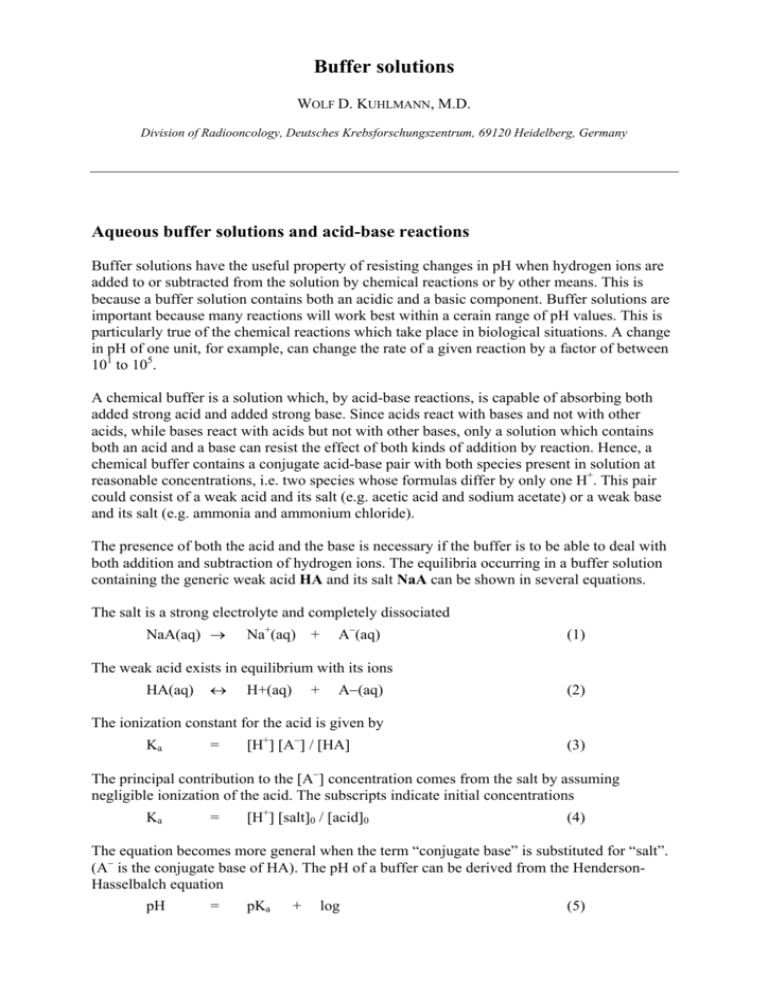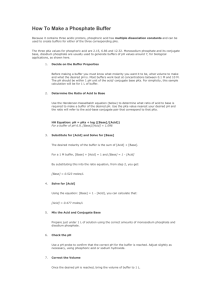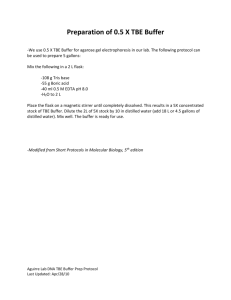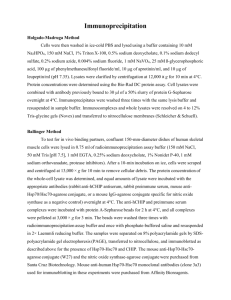Buffer solutions - immunologie
advertisement

Buffer solutions WOLF D. KUHLMANN, M.D. Division of Radiooncology, Deutsches Krebsforschungszentrum, 69120 Heidelberg, Germany Aqueous buffer solutions and acid-base reactions Buffer solutions have the useful property of resisting changes in pH when hydrogen ions are added to or subtracted from the solution by chemical reactions or by other means. This is because a buffer solution contains both an acidic and a basic component. Buffer solutions are important because many reactions will work best within a cerain range of pH values. This is particularly true of the chemical reactions which take place in biological situations. A change in pH of one unit, for example, can change the rate of a given reaction by a factor of between 101 to 105. A chemical buffer is a solution which, by acid-base reactions, is capable of absorbing both added strong acid and added strong base. Since acids react with bases and not with other acids, while bases react with acids but not with other bases, only a solution which contains both an acid and a base can resist the effect of both kinds of addition by reaction. Hence, a chemical buffer contains a conjugate acid-base pair with both species present in solution at reasonable concentrations, i.e. two species whose formulas differ by only one H+. This pair could consist of a weak acid and its salt (e.g. acetic acid and sodium acetate) or a weak base and its salt (e.g. ammonia and ammonium chloride). The presence of both the acid and the base is necessary if the buffer is to be able to deal with both addition and subtraction of hydrogen ions. The equilibria occurring in a buffer solution containing the generic weak acid HA and its salt NaA can be shown in several equations. The salt is a strong electrolyte and completely dissociated NaA(aq) → Na+(aq) + A−(aq) (1) The weak acid exists in equilibrium with its ions HA(aq) ↔ H+(aq) + A−(aq) (2) The ionization constant for the acid is given by Ka = [H+] [A−] / [HA] (3) The principal contribution to the [A−] concentration comes from the salt by assuming negligible ionization of the acid. The subscripts indicate initial concentrations Ka = [H+] [salt]0 / [acid]0 (4) The equation becomes more general when the term “conjugate base” is substituted for “salt”. (A− is the conjugate base of HA). The pH of a buffer can be derived from the HendersonHasselbalch equation pH = pKa + log (5) pH = pKa + log([conj base]0 / [conj acid]0) In this form, the equation may be also used for buffer solutions containing a weak base and its salt where the salt is the acidic component. Aqueous buffer solutions can be prepared by several methods with the basic principle of all of them as described above: the solution must contain the acid and the base of a conjugate in a reasonably similar and reasonably high concentration. In the direct method, the buffer is prepared by mixing the appropriate moles of “conjugate acid” with the appropriate number of moles of “conjugate base”. If the conjugate acid and base are not available, the buffer can be prepared by a indirect method, i.e. by partial conversion of the conjugate acid to conjugate base (and vice versa) using a strong acid or base as appropriate. The buffer capacity depends on the presence of actual moles of conjugate acid and base. For the creation of a buffer solution, an Excel macro calculator (Microsoft® Excel) can be downloaded from BioQUEST homepage for the calculation of the necessary components: Biological ESTEEM Collection (JR JUNGCK ed., Beloit College, Bloit, WI 53511, published by BioQUEST) (http://www.bioquest.org/esteem/esteem_details.php?product_id=207). The user can select an acid and its conjugate base or select an acid or base and combine it with a strong base or strong acid. The desired pH, concentration and volume of the buffer solution is placed in the “Input” box. Then, the appropriate dropdown boxes are used to select acid and base. The finished calculations are displayed in the “Output” box. Buffer solution formulas∗ Buffer formulas to produce aqueous solutions close to the indicated pH values are summarized in the Table below. In most cases, the pH must have to be adjusted using a pH meter and the dropwise addition of either 6 M HCl or 6 M NaOH to one liter of solution. The weights will give 0.1 M concentrations of each species when diluted to 1.0 L; the [acid] : [conjugate base] ratio is unity. ∗ Acid, conjugate acid Base, conjugate base pH value Phosphoric acid (85%) 6.8 mL Monopotassium phosphate 12.8 g 2.1 Citric acid 19.2 g Monopotassium citrate 23.0 g 3.1 Acetic acid, glacial 5.7 mL Sodium acetate 8.2 g 4.75 Monosodium citrate 21.4 g Disodium citrate 23.6 g 5.9 Disodium citrate 23.6 g Trisodium citrate 25.8 g 6.4 Buffer solutions can be toxic. They must be handled with care Monopotassium phosphate 12.8 g Dipotassium phosphate 15.8 g 7.2 Boric acid 31.4 g Sodium hydroxide 4.0 g 9.1 Sodium bicarbonate 8.4 g Sodium carbonate 10.6 g 10.2 Dipotassium phosphate 15.8 g Tripotassium phosphate 19.6 g 12.7 Preparation of buffers from stock solutions In practice, biochemical buffers which cover a range of defined pH-values are prepared from stock solutions of the respective substances by mixing of appropriate amounts. Here are listed some typical examples of widely used buffer solutions for biochemical and histological purposes. Cacodylate buffer 0.05 M pH 5.0-7.4 For electron microscopical studies, sodium cacodylate buffer has been introduced by SABATINI (1963). This buffer is an alternative to Sørensen’s phosphate buffer because high concentrations of phosphate may damage mitochondria and other organelles. Then, a metabolism inhibiting effect is attributed to the arsenate in this buffer solution. Stock solution A: 0.2 M sodium cacodylate [Na(CH3)2 AsO2 ⋅ 3 H2O] dissolve 4.28 g in 100 mL distilled water Stock solution B 0.2 M HCl in distilled water add 20 ml of 1 M HCl to distilled water, adjust to 100 mL Preparation of the buffer solution: mix stock A and stock B according the list below, followed by the addition of distilled water to give a final olume of 400 mL Stock solution A (mL) Stock solution B (mL) pH-value 100.0 94.0 5.0 100.0 90.0 5.2 100.0 86.0 5.4 100.0 78.4 5.6 100.0 69.6 5.8 100.0 59.2 6.0 100.0 47.6 6.2 100.0 36.6 6.4 100.0 26.6 6.6 100.0 18.6 6.8 100.0 12.6 7.0 100.0 8.4 7.2 100.0 5.4 7.4 Phosphate buffer 0.1 M pH 5.3-8.04 (Sørensen) Stock solution A: 0.1 M potassium dihydrogen phosphate dissolve 13.61 g KH2PO4 in 1000 mL distilled water Stock solution B 0.1 M disodium hydrogen phosphate Dissolve 17.8 g Na2HPO4 · 2 H2O in 1000 mL distilled water Preparation of the buffer solution: mix stock A and stock B according to the list below Stock solution A (mL) Stock solution B (mL) pH-value 97.5 2.5 5.30 95.0 5.0 5.60 90.0 10.0 5.91 80.0 20.0 6.24 70.0 30.0 6.47 60.0 40.0 6.64 50.0 50.0 6.81 40.0 60.0 6.98 30.0 70.0 7.17 20.0 80.0 7.38 10.0 90.0 7.73 5.0 95.0 8.04 Tris-HCl buffer 0.05 M pH 7.2-9.0 Stock solution A: 0.2 M Tris dissolve 21.03 g Tris (hydroxymethyl) aminomethane in 1000 mL distilled water Stock solution B 0.1 M HCl in distilled water add 10 ml of 1 M HCl to distilled water, adjust to 100 mL Preparation of the buffer solution: mix stock A and stock B according to the list below, followed by the addition of distilled water to give a final volume of 200 mL Stock solution A (mL) Stock solution B (mL) pH-value 50.0 89.2 7.2 50.0 84.0 7.4 50.0 78.6 7.6 50.0 67.4 7.8 50.0 55.8 8.0 50.0 45.8 8.2 50.0 34.6 8.4 50.0 26.0 8.6 50.0 17.6 8.8 50.0 10.6 9.0 Veronal-acetate buffer 0.028 M pH 3.0-7.4 For the preparation of osmium fixative solutions in electron microscopy, veronalacetate buffers (MICHAELIS L, 1930) are quite common (PALADE GE, 1952). The stock solution C can be omitted. Some authors add also 4.5% sucrose to the fixative. Finally, in place of stock C, Ringer solution may be added. Stock solution A: 2.95 g sodium veronal (final 0.143 M) and 1.94 g sodium acetate ⋅ 3 H2O (final 0.143 M) are dissolved in distilled water to make 100 mL Stock solution B 0.1 M HCl in distilled water add 10 ml of 1 M HCl to distilled water and adjust to 100 mL Stock solution C 8.5 g NaCl (final 8.5%) are dissolved in distilled water to make 100 mL Preparation of the buffer solution: mix stock A, stock B and stock C according to the list below, followed by the addition of distilled water to give a final volume of 100 mL Stock solution A (mL) Stock solution B (mL) Stock solution C (mL) pH-value 20.0 61.6 8.0 3.0 20.0 50.2 8.0 4.0 20.0 35.2 8.0 5.0 20.0 28.4 8.0 6.0 20.0 25.6 8.0 6.8 20.0 24.2 8.0 7.0 20.0 22.6 8.0 7.2 20.0 20.2 8.0 7.4 s-Collidine buffer 0.2 M pH 7.4-7.45 For the preparation of osmium solutions as secondary fixative in electron microscopy (and following an aldehyde fixation), s-collidine as buffer system has been proposed by BENNETT HS and LUFT H (1959). It important to use purified s-collidine (commercially available, or it may be purified by distillation). The buffer is stable at room temperature. Because s-collidine is toxic the buffer should be prepared under a hood. Stock solution A: 2.67 mL collidine(s-collidine purified, final 0.2 M) dissolved in distilled water to make 50.0 mL Stock solution B 1 M HCl in distilled water Preparation of the buffer solution: mix stock A and stock B according to the list below, followed by the addition of distilled water to give a final volume of 100 mL. If needed, the pH of the buffer can be adjusted with HCl. Stock solution A (mL) 50.0 Stock solution B (mL) pH-value 9.0 7.4 Phosphate buffered saline systems (PBS) Phosphate buffered saline (PBS) is a buffer solution widely employed in biochemistry and cell research. The buffer solution contains sodium chloride, sodium phosphate and/or potassium phosphate. Laboratories may follow several ways for the preparation of phosphate buffered saline solutions. There exist formulas for the use of either stock solutions or by weighing directly the solid components into distilled water. Here are given some examples. (a) Phosphate buffer 0.01 M pH 7.4 containing 0.9% NaCl Disodium hydrogen phosphate (Na2HPO4 · 12 H2O) = Sodium dihydrogen phosphate (NaH2PO4 · 2 H2O) = Sodium chlorid (NaCl) = Dissolve in 1000 ml distilled water and adjust pH to 7.4 2.76 0.35 9.0 g g g 10.9 3.2 90.0 g g g (b) Phosphate buffered saline (10x PBS) 0.1 M pH 7.2 Disodium hydrogen phosphate (Na2HPO4 anhydrous) = Sodium dihydrogen phosphate (NaH2PO4 anhydrous) = Sodium chlorid (NaCl) = Dissolve in 1000 ml distilled water and adjust pH to 7.2 Dilute 1:10 with distilled water prior to use and adjust pH if necessary (c) Phosphate buffered saline (10x PBS) 0.1 M pH 7.4 Disodium hydrogen phosphate (Na2HPO4 anhydrous) = 14.4 g Sodium dihydrogen phosphate (KH2PO4 anhydrous) = 2.4 g Sodium chloride (NaCl) = 80.0 g Potassium chloride (KCl) = 2.0 g Dissolve in 1000 ml distilled water; pH is about 6.8, but when diluted to 1x PBS pH will change to 7.4; on dilution, the final 1x PBS will have a pH 7.4 and a final concentration of 10 mM phosphate, 137 mM NaCl and 2.7 mM KCl (d) Phosphate buffer and phosphate buffered saline (PBS) 0.05 M pH 6.6-7.6 Stock solution A: 1 M KH2PO4 Potassium dihydrogen phosphate in distilled water Stock solution B 1 M K2HPO4 Dipotassium hydrogen phosphate in distilled water Stock solution C 5 M NaCl Sodium chloride in distilled water Example for a 0.05 M phosphate buffer pH 7.0: the solution is prepared by mixing 21.1 mL of stock A and 28.9 mL of stock B and dilution to one liter with distilled water; the desired pH should be confirmed by a pH meter. Preparation of 0.05 M phosphate buffer solution Stock solution A (mL) Stock solution B (mL) pH-value 32.0 18.0 6.6 29.8 20.2 6.7 26.5 23.5 6.8 24.0 26.0 6.9 21.1 28.9 7.0 18.4 31.6 7.1 16.8 34.2 7.2 13.4 36.6 7.3 11.2 38.8 7.4 9.4 40.6 7.5 7.8 42.2 7.6 Example for PBS with 0.05 M phosphate buffer pH 7.0: the solution is prepared by mixing of 15.6 mL of stock A, 34.4 mL of stock B, 30.0 mL of stock C and dilution to one liter with distilled water; the desired pH should be confirmed by a pH meter. Preparation of 0.05 M phosphate buffer solution Stock A (mL) Stock B (mL) Stock C (mL) pH-value 26.6 23.4 6.6 23.7 26.3 6.7 20.9 29.1 6.8 18.1 31.9 6.9 15.6 34.4 7.0 13.2 36.8 7.1 11.1 38.9 7.2 9.2 40.8 7.3 7.6 42.4 7.4 6.3 43.7 7.5 5.1 44.9 7.6 Be aware that sodium chloride lowers pH approximately 0.01 pH unit for each 0.01 increase in molarity (RG BATES 1973). Furthermore, pH of phosphate buffers increases with decreasing temperature. Compared with a buffer at 25°C, buffers at 4°C will be 0.08 higher and a buffer at 37°C will be 0.025 lower. The concentration of phosphate also influences pH. The dilution value for phosphate, defined as the change of pH of a buffer when diluted with an equivalent volume of water is 0.08 (RG BATES 1962). To give an example, a 0.025 M phosphate buffer prepared with half of the volumes as indicated in the Table for a specific pH (see above), would be approximately 0.08 pH units higher than the expected pH. A JavaScript that calculates the necessary components for phosphate buffers can be used under the link http://home.fuse.net/clymer/buffers/phos.html. For more details and formulations of buffers with special reference to electron microscopic use we recommend AM GLAUERT (1975) and G MILLONIG (1976). Then, many practical aspects in the use and preparation of buffer solutions for biomedical experiments are given in The Handbook of Experimental Immunology (WEIR DM, ed.), volume 4: Applications of immunological methods in biomedical sciences (1986). The Manual of Clinical Laboratory Immunology (ROSE NR, FRIEDMAN H and FAHEY JL, eds., 1986) and Antibodies: a Laboratory Manual (HARLOW E and LANE D, eds., 1988) are also useful sources of buffer systems for biomedical experiments. Selected publications for further readings Michaelis L (1930) Palade GE (1952) Bennet HS and Luft JH (1959) Bates RG (1962) Bates GR (1973) Good NE et al. (1966) Glauert AM (1975) Millonig G (1976) Rose NR et al. (1986) Weir DM et al. (1986) Harlow E and Lane D (1988) Stoll V and Blanchard JS (1990) Full version of citations in chapter References. © Prof. Dr. Wolf D. Kuhlmann, Heidelberg 10.09.2006






